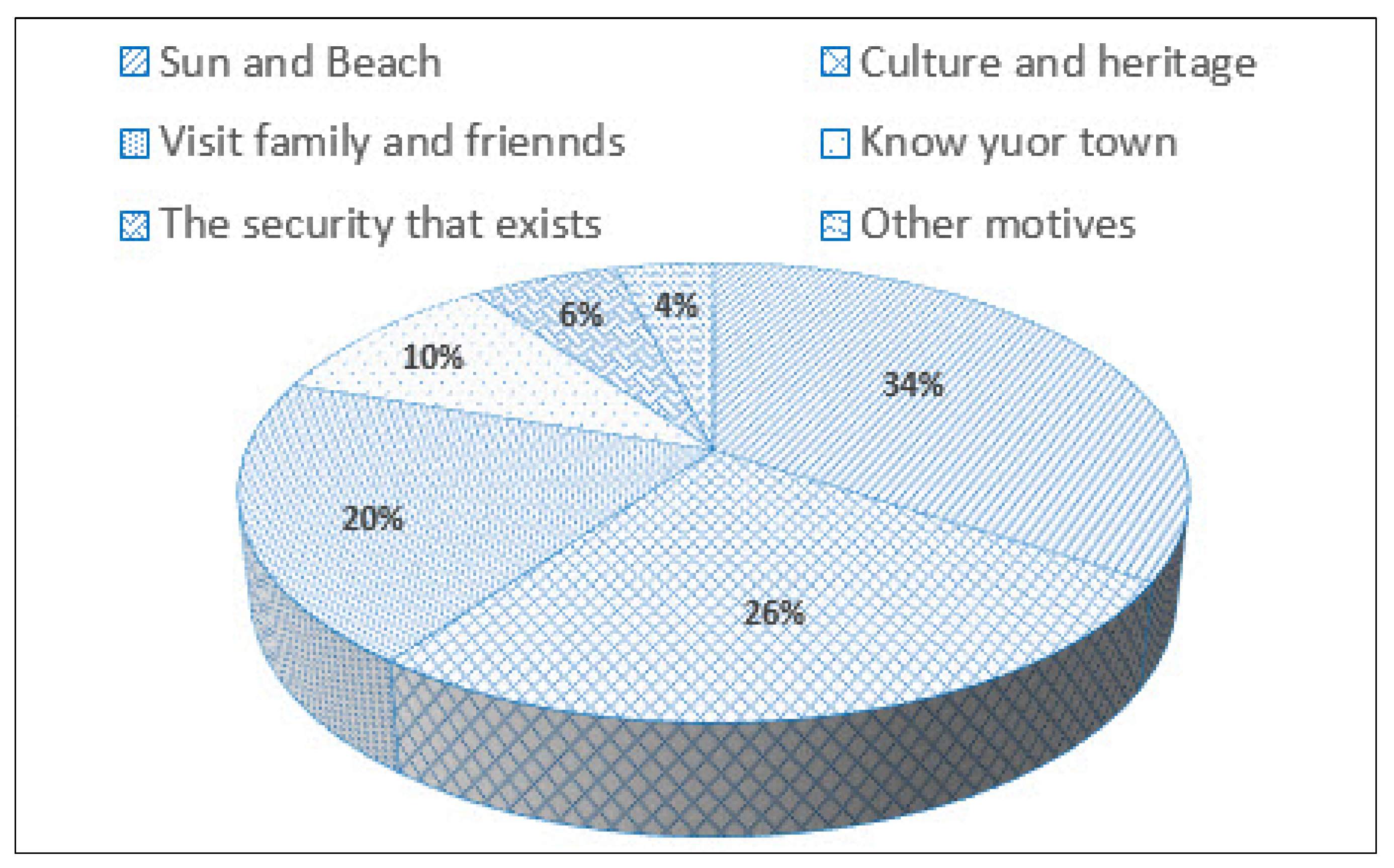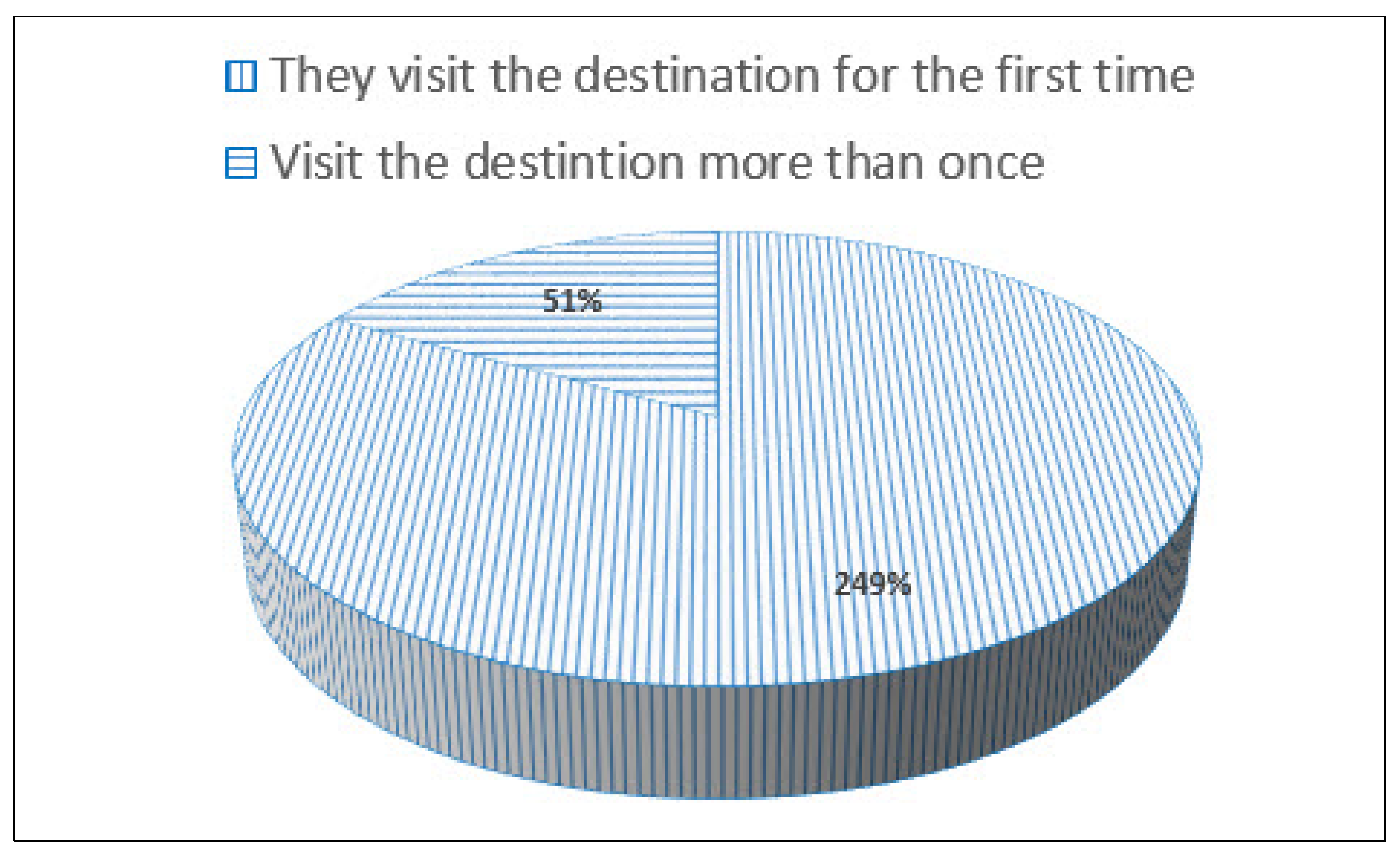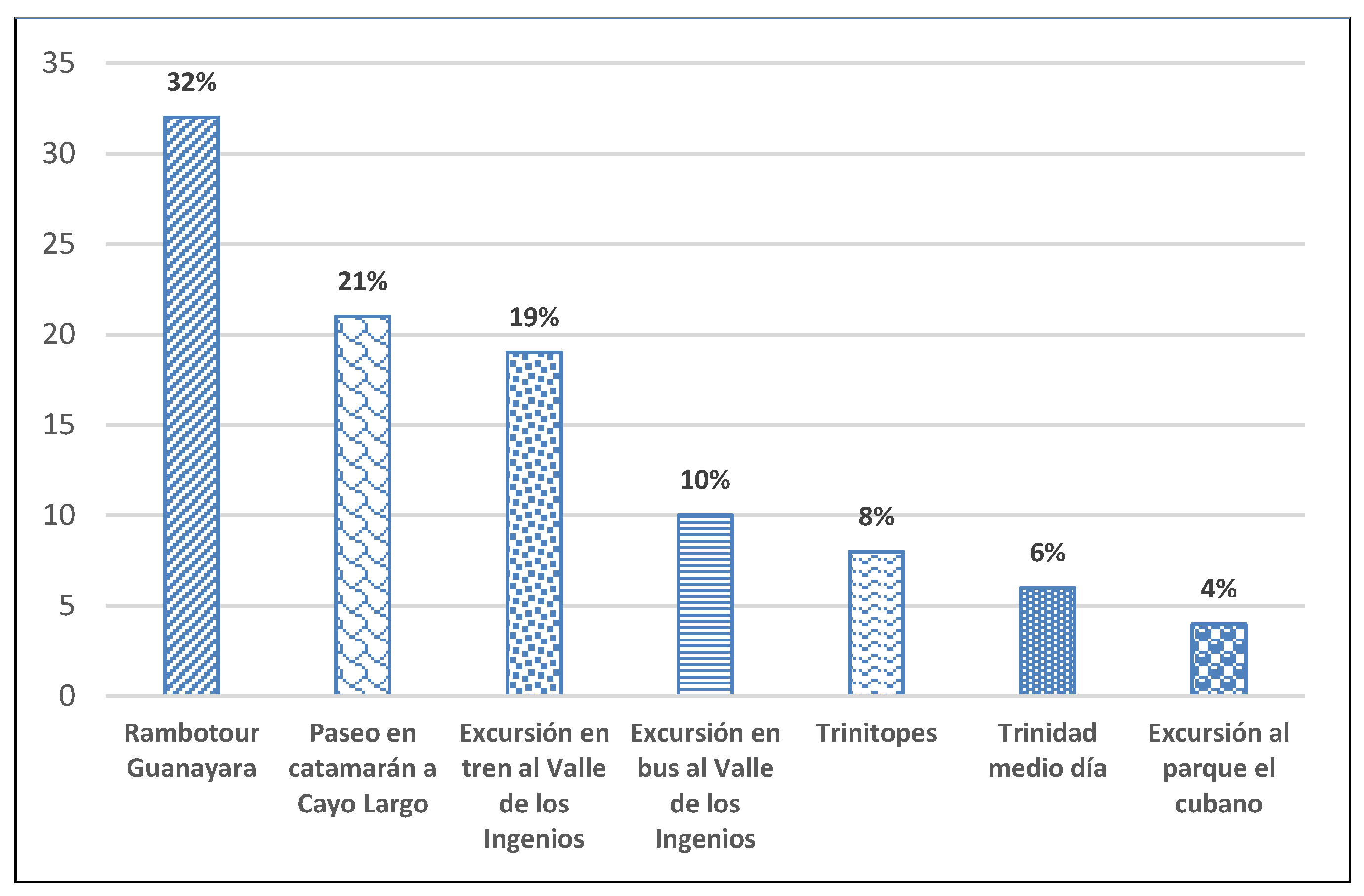An Analysis of Tourism Demand as a Projection from the Destination towards a Sustainable Future: The Case of Trinidad
Abstract
:1. Introduction
2. Materials and Methods
2.1. Study Area
2.2. Methodological Framework
2.3. Data and Data Sources
2.4. Theoretical Delimitation
3. Results
4. Discussion
5. Conclusions
Author Contributions
Funding
Institutional Review Board Statement
Informed Consent Statement
Data Availability Statement
Acknowledgments
Conflicts of Interest
References
- Carvache-Franco, M.; Carvache-Franco, W.; Molina, G.; Arteaga, M.y.V.C. La Demanda Turística Desde la Perspectiva de la Satisfacción, la Actitud y las Preferencias Respecto a su Gastronomía: El caso de Salitre (Ecuador). Rev. Tur. Soc. 2018, 22, 151–165. Available online: https://revistas.uexternado.edu.co/index.php/tursoc/article/view/5349/6544 (accessed on 20 August 2020). [CrossRef] [Green Version]
- Monge-Martínez, J.; Gaviño-Ortiz, N.; Vaca-Vaca, C.; Salazar-Mera, J. Oferta y demanda de los guías de turismo de la Zona 3-Ecuador. Bol. Coyunt. 2018, 17, 18–22. [Google Scholar] [CrossRef] [Green Version]
- THCG. Análisis del Desarrollo de Turismo en Cuba en el año 2017; THCG: La Habana, Cuba, 2018. [Google Scholar]
- Torres, G.A. El turismo Sostenible Comunitario en Puerto el Morro: Análisis de su Aplicación e Incidencia Económica. Univ. Soc. 2019, 11, 1. Available online: http://scielo.sld.cu/scielo.php?script=sci_arttext&pid=S2218-36202019000100289 (accessed on 20 August 2020).
- Alexandro. Identidad y Desarrollo.com. 12 October 2019. [En línea]. Available online: https://identidadydesarrollo.com/desarrollo-comunitario-y-turismo-sostenible (accessed on 15 March 2022).
- Burunate, J.C.; Fong, I.G. Turismo ¿Cartas bajo la Manga? Rev. Bohemia 2016, 1, 28–34. Available online: http://bohemia.cu/en-cuba/2016/06/turismo-cartas-bajo-la-manga/ (accessed on 20 August 2020).
- Maldonado, C.; Hernández, G. Guía para Autogestión de Sostenibilidad. Destinos Turísticos Comunitarios; Organización Internacional del Trabajo Para: América Latina, Lima, Perú, 2011; Available online: https://www.ilo.org/wcmsp5/groups/public/---americas/---ro-lima/documents/publication/wcms_185024.pdf (accessed on 24 August 2020).
- Organización Mundial del Turismo (OMT). Panorama OMT del Turismo Internacional. UNWTO, 2017, p. 16. Available online: https://ibce.org.bo/images/publicaciones/Panorama-OMT-Turismo-2017.pdf (accessed on 5 September 2020).
- Castro, H.A. Comportamiento de Ingresos por Turismo Internacional en Cuba 2014–2018. Econ. Desarro. 2020, 163, 1–10. Available online: http://scielo.sld.cu/scielo.php?script=sci_arttext&pid=S0252-85842020000100013 (accessed on 10 September 2021).
- Organización Mundial del Turismo (OMT). Panorama del Turismo Internacional; UNWTO: Madrid, Spain, 2019; p. 24. Available online: https://www.e-unwto.org/doi/pdf/10.18111/9789284421237 (accessed on 10 February 2022).
- Eduardo, S.C.; Eros, S.C.; Cerdan, L.M.I. El Turismo en Cuba: Desarrollo, Retos y Perspectivas. Rosa Ventos 2019, 11, 23–49. Available online: https://www.redalyc.org/journal/4735/473559029004/html/#:~:text=El%20turismo%20como%20fuente%20de,realidad%20mundial%2C%20hasta%20el%202016 (accessed on 15 December 2021).
- Organización Internacional del Turismo (OMT). Panorama OMT TurismoInternacional; UNWTO: Madrid, Spain, 2016; p. 16. Available online: https://www.e-unwto.org/doi/pdf/10.18111/9789284418152 (accessed on 12 February 2022).
- Mintur. Informe del Comportamiento del Turismo Receptivo al Cierre del año 2017; Mintur: La Habana, Cuba, 2018. [Google Scholar]
- Reyes, M.L.; Cantera, C.D. Análisis económico de indicadores en el sector turístico. Alfa 2019, 1, 53–69. [Google Scholar]
- Rodríguez, J.L.; Chávez, E.S. Desafíos Para el Desarrollo del Turismo en Cuba. El nuevo Escenario Post COVID-19. Estud. Desarro. Soc. 2021, 9, 1–6. Available online: http://scielo.sld.cu/scielo.php?script=sci_arttext&pid=S2308-01322021000200020 (accessed on 10 February 2022).
- Cubanet. Cuba no Llegará a los 5 Millones de Turistas en 2018, Reconoce el Régimen. Available online: https://www.cubanet.org/noticias/cuba-descarta-objetivo-5-millones-turistas-este-ano/ (accessed on 19 July 2021).
- Hosteltur. Cuba Registra un Crecimiento en Turistas de un 7% en el Primer Trimestre. 2018. Available online: https://www.hosteltur.com/127788_cuba-registra-crecimiento-turistas-internacionales-7.html (accessed on 10 March 2021).
- Thomas, J.H.; Kitterlin-Lynch, M.y.L.D.V.D. Cuba’s Future Hospitality and Tourism Business: Opportunities and Obstacles. CubCornell Hosp. Rep. 2015, 15, 6–16. Available online: https://ecommons.cornell.edu/handle/1813/71200 (accessed on 7 July 2021).
- Perelló, J.L. El Turismo en Cuba: Cambios y Tendencias. 2019. Available online: https://horizontecubano.law.columbia.edu/news/el-turismo-en-cuba-cambios-y-tendencias (accessed on 13 August 2021).
- CFN. Ficha Sectorial: Sector del Turismo, Nivel Nacional. La Habana. 2017. Available online: https://www.cfn.fin.ec/wp-content/uploads/2017/10/Ficha-Sectorial-Turismo.pdf (accessed on 3 July 2021).
- Pérez, A.C.; Campos, H. El Turismo, Fenómeno Social en Ascenso, Evolución, Concepciones y Singularidades en Cuba. TURyDES 2012, 5, 1. Available online: https://www.eumed.net/rev/turydes/12/cpco.html (accessed on 10 June 2021).
- Pérez, Y.S.; Martins, R.S.; Pallerols, G.M.C. Impacto Social y Económico de la Industria Turística en Cuba. TURyDES 2010, 3, 1. Available online: https://www.eumed.net/rev/turydes/08/pmp.htm (accessed on 17 March 2021).
- Orrantia, D.M. Principales Impactos Económicos del Turismo en la Economía Cubana en las dos Últimas Décadas; Universidad de Matanzas Camilo Cienfuegos: Matanzas, Cuba, 2008; Available online: http://monografias.umcc.cu/monos/2008/Indeco/m0899.pdf (accessed on 18 July 2021).
- Castillo, O.G.; Gaspar, N.G. Cuba, Turismo y Desarrollo Económico. Cuba Siglo XXI Econ. 2000, 1, 1. Available online: https://www.nodo50.org/cubasigloXXI/economia/gutierrez3_310802.htm (accessed on 11 July 2020).
- Cisneros Mustelier, L.; García, L. Contribución del Turismo al Desarrollo local en Cuba Desde la Perspectiva de la Gestión de destino. Rev. Científica Ecociencia 2021, 2, 1–15. Available online: https://revistas.ecotec.edu.ec/index.php/ecociencia/article/view/580 (accessed on 15 February 2022).
- UNWTO. Turismo: Panorama 2020. In Previsiones Mundiales y Perfiles de los Segmentos de Mercado; Turismo, O.M.d., Ed.; UNWTO: Madrid, Spain, 2002; 143p, Available online: https://www.e-unwto.org/doi/book/10.18111/9789284404766 (accessed on 16 July 2020).
- Venegas, H. Trinidad de Cuba: Corsarios, azúcar y revolución en el Caribe; Oficina del Conservador de la Ciudad de Trinidad: Trinidad, Cuba, 2006; p. 150. [Google Scholar]
- Venegas, C. Reseña de Trinidad de Cuba: Corsarios, Azúcar, y Revolución en el Caribe de Hernán Venegas Delgado. Caribb. Stud. 2008, 36, 154–156. Available online: https://www.redalyc.org/pdf/392/39214802010.pdf (accessed on 11 July 2020).
- Salinas, E.; Echarri, M.; Salinas, E. Apuntes Geografía Turística de Cuba; Editorial Universitaria Félix Varela: La Habana, Cuba, 2008; Available online: http://repositorio.geotech.cu/jspui/bitstream/1234/3135/1/Apuntes%20geograf%C3%ADa%20tur%C3%ADstica%20de%20Cuba.pdf (accessed on 10 July 2020).
- Salinas, E. Geografía y Turismo Aspectos Territoriales del Manejo y Gestión del Turismo; Editorial Universitaria Félix Varela: La Habana, Cuba, 2013. [Google Scholar]
- Machado, T. Evolución y organización de la economía azucarera cubana desde finales del siglo XVIII hasta 1925. Contrib. Cienc. Soc. 2012, 1, 1. Available online: https://www.eumed.net/rev/cccss/20/tmm2.html (accessed on 7 July 2020).
- Priest, C. La Historia y la Transformación de Cuba Desde la Optica de la Industria. Yale Law School 2020. Available online: https://fdocuments.ec/document/la-historia-y-la-transformacion-de-cuba-desde-la-optica-1-la-historia-y-la.html?page=1 (accessed on 26 September 2021).
- Abreu Pupo, A. Génesis y Evolución de la Plantación ESCLAVISTA azucarera en la Cuba Colonial Hasta 1868. Contrib. Cienc. Soc. 2011, 1, 1. Available online: https://ideas.repec.org/a/erv/coccss/y2011i2011-1039.html (accessed on 11 July 2020).
- Brusone, J.L.R. Sobre la Industria Azucarera de Cuba Durante el siglo XIX. El Trimest. Econ. 1944, 11, 1–6. Available online: https://www.jstor.org/stable/i20854602?refreqid=excelsior%3A2ee5b4b09a033f80cd9589d9f8edf8ba (accessed on 8 July 2020).
- Delgado, A.; Martín, R. Pronóstico de la Demanda Turística Hacia Cuba Considerando el Impacto del Cambio Climático. Rev. Caribeña Cienc. Soc. 2014, 1, 1–22. Available online: https://www.eumed.net/rev/caribe/2014/08/pronostico-demanda-turistica.html (accessed on 17 August 2020).
- Gregorio, C.M.; José, S.D. Trinidad, producto turístico integral y sostenible en Cuba. Cuad. Tur. 2011, 27, 95–114. Available online: https://revistas.um.es/turismo/article/view/139781 (accessed on 10 November 2020).
- Nolasco, A. La Dimensión Urbana del Espacio Turístico de la Costa Blanca. Ocupación, Espacio y Complejidad en Dénia, Benidorm y Torrevieja. Ph.D. Thesis, Archivo Institucional de la Universidad de Alicante, San Vicente del Raspeig, Spain, 2015. [Google Scholar]
- Sampieri, R.H.; Collado, C.F.; Lucio, M.d.P.B. Metodología de la Investigación Quinta Edición; McGraw-Hill: México City, México, 2010; Available online: https://www.icmujeres.gob.mx/wp-content/uploads/2020/05/Sampieri.Met.Inv.pdf (accessed on 15 July 2021).
- Moll de Alba Cabot, J.E. La Demanda Turística Urbana: Modelos Estructurales de Comportamiento de los Turistas de Barcelona; Universidad de Girona: Girona, Spain, 2016; Available online: https://www.tdx.cat/handle/10803/399792#page=2 (accessed on 26 September 2021).
- Talaya, Á.E. Modelos de la Demanda Turística en España: Segmentación por Países de Procedencia. Mediterráneo Económico 2019, 5, 81–101. Available online: https://www.publicacionescajamar.es/publicacionescajamar/public/pdf/publicaciones-periodicas/mediterraneo-economico/5/5-56.pdf (accessed on 6 November 2021).
- Torres, M.; De la Rosa, J.A.; Lao, Y. Pronóstico de la demanda turística del Hotel Brisas Guardalavaca de Holguín a través de una red neuronal artificial. Rev. Investig. Latinoam. Compet. Organ. 2021, 1, 2–6. Available online: https://dialnet.unirioja.es/servlet/articulo?codigo=7879444 (accessed on 10 February 2022).
- Lao-León, Y.O.; Rivas-Méndez, A.; Pérez-Pravia, M.C.; Marrero-Delgado, F. Procedimiento para el pronóstico de la demanda mediante redes neuronales artificiales. Cienc. Holguín/Rev. Trimest. 2017, 23, 43–59. Available online: https://www.redalyc.org/journal/1815/181549596004/html/ (accessed on 5 July 2020).
- Coromoto, M.M.M. Turismo y producto turístico. Evolución, conceptos, componentes y clasificación. Visión Gerenc. 2011, 1, 135–158. Available online: https://www.redalyc.org/pdf/4655/465545890011.pdf (accessed on 20 August 2020).
- González, Á.M.; Santa Cruz, D. Turismo senior: Análisis del comportamiento de las edades de los clientes que visitan el hotel X. Varadero, Cuba. RES NON VERBA 2014, 4, 20–25. Available online: https://biblio.ecotec.edu.ec/revista/edicion5/TURISMO%20SENIOR.pdf (accessed on 25 August 2020).
- Díaz-Pompa, F.; Leyva-Fernández, L.d.l.C.; Pérez, O.L.O.; Mulet, Y.S. El turismo rural sostenible en Holguín. Estudio prospectivo panorama 2030. El Periplo Sustentable 2020, 38, 174–193. Available online: https://rperiplo.uaemex.mx/article/view/9265 (accessed on 20 July 2021). [CrossRef]
- Corvo, M.d.l.V.S.; Lamorú, I.R.; González, D.C.; González, Y.N. Medición de la estacionalidad: Premisas para la determinación de opciones en la estacionalización de la demanda turística. TURyDES 2012, 5, 1. Available online: https://www.eumed.net/rev/turydes/13/clgg.html (accessed on 21 August 2020).
- María, R.M.L. Conceptualización de la demanda turística. Cienc. Holguín 2009, 15, 1–8. Available online: https://www.redalyc.org/pdf/1815/181517987002.pdf (accessed on 25 November 2020).
- Perelló Cabrera, J.L. Contribución de la Diáspora Cubana al Crecimiento del Turismo Internacional en Cuba. Ara Rev. Investig. Tur. 2017, 5, 21–31. Available online: https://revistes.ub.edu/index.php/ara/article/view/19062 (accessed on 25 August 2020).
- Demelas, R. Los Determinantes de la Demanda Turística y sus Implicaciones en Términos de Estacionalidad; Universidad Autónoma de Barcelona: Barcelona, Spain, 2009; Available online: https://ddd.uab.cat/pub/trerecpro/2009/hdl_2072_209327/treball_recerca_rdemelas.pdf (accessed on 12 February 2020).
- Hammood, W.A.; Arshah, R.A.; Mohamad, A.S.; Al, H.H.; Al-Abri, O.H.y.S. Una revisión sistemática del sistema de respuesta y alerta temprana contra inundaciones (FEWRS): Una revisión y un análisis profundos. Sostenibilidad 2021, 13, 440. [Google Scholar]
- Panosso, A.; Lohmann, G. Teoría del Turismo. In Conceptos, Modelos y Sistemas; Editorial Trillas: Mexico City, Mexico, 2012; p. 290. [Google Scholar]
- David, F.R.; María, d.l.O.B. La demanda turística internacional, medio siglo de evolución. Revista de Economía Mundial 2012, 32, 127–149. Available online: https://www.redalyc.org/pdf/866/86625395006.pdf (accessed on 6 December 2021).
- Pelegrín, N.; Cabezas, E.; Pelegrín, A. Diseño y gestión del turismo sostenible. Propuesta para el desarrollo comunitario de la localidad de Arango, Cuba. Núm. Extra 2021, 134–152. Available online: https://encuentros.unermb.web.ve/index.php/encuentros/article/view/153 (accessed on 20 February 2022).
- Narváez, M.; Fernández, G. El turismo desde la perspectiva de la demanda. Lugar de estudio provincia de Paraguaná-Venezuela. Rev. UDCA Actual. Divulg. Cient. 2010, 13, 175–183. Available online: http://www.scielo.org.co/pdf/rudca/v13n2/v13n2a20.pdf (accessed on 20 August 2020).
- Socatelli, M. Extracto del Libro: Mercadeo Aplicado al Turismo. La Comercialización de Servicios-Productos y Destinos Turísticos Sostenibles; Universidad Estatal a Distancia de Costa Rica: San José, CA, USA, 2013; Available online: https://www.ucipfg.com/Repositorio/MGTS/MGTS15/MGTSV15-07/semana3/LS3.1.pdf (accessed on 20 August 2020).
- Li, Y.; Wang, X.; Dong, X. Delineación de una red integrada de corredores ecológicos y culturales: Un estudio de caso en Beijing, China. Sostenibilidad 2021, 13, 412. [Google Scholar]
- Mohamed, B.H.; Disli, M.; Al-Saday, M.B.; Koç, M. Investigation on Human Development Needs, Challenges, and Drivers for Transition to Sustainable Development: The Case of Qatar. Sustainability 2022, 14, 3705. [Google Scholar] [CrossRef]
- Bastidas, R.F.A.; Domínguez, E.S.; Argandoña, E.V.S.; Guevara, N.A. Análisis de los productos turísticos: Caso Península de Santa Elena. Ecuador. Revista UEES 2020, 38, 1. Available online: https://revistas.uees.edu.ec/index.php/Podium/article/view/520/469 (accessed on 21 August 2021). [CrossRef]
- Martínez, E. Consideraciones Geográficas en Torno al Binomio Clima Turismo: Aplicación al Litoral Alicantino. Ph.D. Thesis, Universidad de Alicante, San Vicente del Raspeig, Spain, 2006. Available online: https://dialnet.unirioja.es/servlet/tesis?codigo=57174 (accessed on 15 November 2020).
- Carvache, M. Análisis de la Segmentación y Motivación de la Demanda del Ecoturismo: Aplicación en Áreas Protegidas en Ecuador; Universidad Politécnica de Valencia: Valencia, España, 2019; Available online: https://riunet.upv.es/bitstream/handle/10251/121136/Carvache%20-%20An%C3%A1lisis%20de%20la%20segmentaci%C3%B3n%20y%20motivaci%C3%B3n%20de%20la%20demanda%20del%20ecoturismo%3A%20Aplicaci%C3%B3n%20en%20%C3%A1....pdf?sequence=4 (accessed on 20 August 2020).
- Eduardod, O.S.G. Modelos teóricos aplicados al turismo. Estudios y Perspectivas en Turismo 2007, 16, 96–108. Available online: https://www.redalyc.org/pdf/1807/180713890005.pdf (accessed on 5 November 2021).
- Luis, M.G.J. Patrimonio e Identidad: Un Enfoque geo Histórico. Heritage and Identity: A geohistorico Aproach. 2018, pp. 19–27. Available online: https://www.grupocieg.org/archivos_revista/Ed.%2031(19-27)-Machado%20Jose_articulo_id355.pdf (accessed on 20 June 2020).
- Iturbide, R.M. Patrimonio e Identidad. 2015. Available online: http://politicasculturales.com.mx/2015/patrimonio-e-identidad.html (accessed on 10 December 2021).
- Navarro, E.R. Patrimonio Cultural e Identidad. Argumentos Teóricos. 2015, p. 13. Available online: https://www.grin.com/document/307464 (accessed on 19 November 2021).
- Organización de las Naciones Unidas (ONU). Declaración de Estocolmo 1972. Conferencia sobre el Medio Ambiente y Desarrollo. Available online: http://www.ordenjuridico.gob.mx/TratInt/Derechos%20Humanos/INST%2005.pdf (accessed on 20 July 2020).
- Jiménez, C.C. Turismo Sostenible: Una revisión conceptual aplicada. El Periplo Sustentable 2006, 1, 5–21. Available online: https://www.redalyc.org/pdf/1934/193420679001.pdf (accessed on 20 August 2021).








| No | Activities | Service Provided | Resource Management |
|---|---|---|---|
| 1 | Restaurant Jigüe | Restaurant | State |
| 2 | Restaurant Colonial | Restaurant | State |
| 3 | Guanahuac Tavern | Restaurant | State |
| 4 | Aché | Restaurant | Private |
| 5 | The Sailor | Restaurant | Private |
| 6 | The Golden | Restaurant | Private |
| 7 | Hotel La Ronda | Accommodation | State |
| 8 | Hostel Bitterness | Accommodation | State |
| 9 | ICAP House | Accommodation | State |
| 10 | Hostal Yanara Fambi | Accommodation | private |
| 11 | Hostal Casa Mía | Accommodation | private |
| 12 | Hostal Cabriales | Accommodation | private |
| 13 | Romantic Museum | Cultural | State |
| 14 | Art Gallery | Cultural | State |
| 15 | Travel agency | Services | State |
| Claims Made | Satisfied Demands | Unsatisfied Demands | ||
|---|---|---|---|---|
| Tourists in State Facilities | Tourists in Private Hostels | Tourists in State Facilities | Tourists in Private Hostels | |
| Enjoy the sun and the beach | 75 | 68 | 0 | 0 |
| Horseback riding | 5 | 50 | 10 | 0 |
| Speleotourism | 3 | 7 | 5 | 0 |
| Gastronomic tourism | 12 | 22 | 0 | 0 |
| Cycle tourism | 7 | 32 | 0 | 4 |
| Agrotourism | 5 | 7 | 3 | 0 |
| Get to know the people and their customs and traditions | 26 | 36 | 7 | 0 |
| Museum visits | 32 | 25 | 0 | 0 |
| Visit to other heritage sites (churches, squares, buildings, etc.) | 35 | 29 | 9 | 0 |
| Observation or photo hunting of species of flora and fauna | 0 | 15 | 13 | 3 |
| Hiking, walking, orienteering tour in the countryside | 5 | 28 | 17 | 7 |
| Enjoy cultural and sports shows | 60 | 45 | 10 | 13 |
| Adventure tourism: climbing, canyoning, rafting, canopy or zip line | 4 | 18 | 10 | 5 |
| Sailing and other nautical activities, diving, sport fishing | 25 | 18 | 5 | 5 |
| Academic, learning, and event tourism | 0 | 3 | 0 | 1 |
| Shopping tourism | 16 | 25 | 4 | 0 |
Publisher’s Note: MDPI stays neutral with regard to jurisdictional claims in published maps and institutional affiliations. |
© 2022 by the authors. Licensee MDPI, Basel, Switzerland. This article is an open access article distributed under the terms and conditions of the Creative Commons Attribution (CC BY) license (https://creativecommons.org/licenses/by/4.0/).
Share and Cite
Pelegrín Naranjo, L.; Pelegrín Entenza, N.; Vázquez Pérez, A. An Analysis of Tourism Demand as a Projection from the Destination towards a Sustainable Future: The Case of Trinidad. Sustainability 2022, 14, 5639. https://doi.org/10.3390/su14095639
Pelegrín Naranjo L, Pelegrín Entenza N, Vázquez Pérez A. An Analysis of Tourism Demand as a Projection from the Destination towards a Sustainable Future: The Case of Trinidad. Sustainability. 2022; 14(9):5639. https://doi.org/10.3390/su14095639
Chicago/Turabian StylePelegrín Naranjo, Lestter, Norberto Pelegrín Entenza, and Antonio Vázquez Pérez. 2022. "An Analysis of Tourism Demand as a Projection from the Destination towards a Sustainable Future: The Case of Trinidad" Sustainability 14, no. 9: 5639. https://doi.org/10.3390/su14095639
APA StylePelegrín Naranjo, L., Pelegrín Entenza, N., & Vázquez Pérez, A. (2022). An Analysis of Tourism Demand as a Projection from the Destination towards a Sustainable Future: The Case of Trinidad. Sustainability, 14(9), 5639. https://doi.org/10.3390/su14095639






